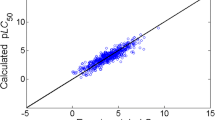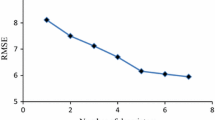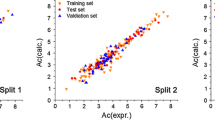Abstract
Substituted phenols, anilines, pyridines and mononitrobenzenes can be classified as polar narcotics. These chemicals differ from non-polar narcotic compounds not only in their toxic potency (normalized by log Kow), but also in their Fish Acute Toxicity Syndrome profiles, together suggesting a different mode of action.
For 97 polar narcotics, which are not ionized under physiological conditions, 11 physico-chemical and quantum-chemical descriptors were calculated. Using principal component analysis, 91 % of the total variance in this descriptor space could be explained by three principal components which were subsequently used as factors in a statistical design. Eleven compounds were selected based on a two-level full factorial design including three compounds near the center of the chemical domain (a 23+3 design).
QSARs were developed for both the design set and the whole set of 63 polar narcotics for which guppy and/or fathead minnow data were available in the literature. Both QSARs, based on partial least squares regression (3 latent variables), resulted in good models (R2=0.96 and Q2=0.82; R2=0.86 and Q2=0.83 respectively) and provided similar pseudo-regression coefficients. In addition, the model based on the design chemicals was able to predict the toxicity of the 63 compounds (R2 =0.85).
Models show that acute fish toxicity is determined by hydrophobicity, HOMO-LUMO energy gap and hydrogen-bond acceptor capacity.
Similar content being viewed by others
References
J. L. M. Hermens in:Hutzinger, O. (Ed.): Handbook of Environmental Chemistry. Vol. 2E, Springer Verlag, Berlin 1989, pp. 111–162
J. L. M. Hermens in:Karcher, W. andDevillers, J. (Eds.): Practical Applications of QSAR in Environmental Chemistry and Toxicology. Kluwer Academic Publishers, Dordrecht 1990, pp. 263–280
M. Sjöström;L. Eriksson, in van de Waterbeemd, H. (Ed.): Methods and principles in medicinal chemistry. Vol. 2 (Chemometric Methods in Molecular Design), Verlag Chemie, Weinheim 1995, pp. 63–40
L. Eriksson;J. Jonsson;S. Hellberg;F. Lindgren;B. SkagerBerg;M. Sjostrom;S. Wold;R. Berglind: Environ. Toxicol. Chem. 9, 1339–1351 (1990)
S. Wold;M. Sjöström;R. Carlson;T. Lundstedt;S. Hellberg;B. Skagerberg;C. Wikström;J. Öhman: Anal. Chim. Acta 191, 17–32 (1986)
H. J. M. Verhaar;C. J. van Leeuwen;J. L. M. Hermens: Chemosphere 25 (4), 471–491 (1992)
C. J. van Leeuwen;P. T. J. van der Zandt;T. Aldenberg;H. J. M. Verhaar;J. L. M. Hermens: Environ. Toxicol. Chem. 11, 267–282 (1992)
H. J. M. Verhaar;C. J. van Leeuwen;J. Bol;J. L. M. Hermens: SAR & QSAR Environ. Res. 2, 39–58 (1994)
S. P. Bradbury;T. R. Henry;G. J. Niemi: Environ. Toxicol. Chem. 8, 247–261 (1989)
G. D. Veith;S. J. BroderiuS: Environ. Health Persp. 87, 207–211 (1990)
H. J. M. Verhaar;E. Urrestarazu Ramos;J. L. M. Hermens: J. Chemometr. 10, 149–162 (1996)
G. D. Veith;S. J. Broderius in:Kaiser, K. L. E. (Ed.): QSAR in Environmental Toxicology- II, D. Reidel Publishing Company, Dordrecht 1986, pp. 385–391
T. W. Schultz;G. W. Holcombe;G. L. Phipps: Ecotoxicol. Environ. Safety 12, 146–153 (1986)
D. W. Roberts in:Kaiser, K.L.E. (Ed.): QSAR in Environmental Toxicology - II, D. Reidel Publishing Company, Dordrecht 1986, pp. 295–308
L. H. Hall;L. B. Kier: Bull. Environ. Contam. Toxicol. 32, 354–362 (1984)
J. Saarikoski;M. Viluksela: Ecotoxicol. Environ. Safety 6, 501–512 (1982)
J. L. M. Hermens;P. Leeuwangh, A. Musch: Ecotoxicol. Environ. Safety 8, 388–394 (1984)
V. K. Gombar in:Kaiser, K.L.E. (Ed.): QSAR in Environmental Toxicology - II, D. Reidel Publishing Company, Dordrecht 1986, pp. 125–133
H. Könemann;A. Musch: Toxicology 19, 223–228 (1981)
G. Bringmann;R. Z. Kühn: Wasser-Abwasser-Forsch. 10(5), 161–166(1977)
G. A. Leblanc: Bull. Environ. Contam. Toxicol. 24(5), 684–691 (1980)
R. Kühn;M. Pattard;K. Pernak;A. Winter: Water Res. 23(4), 501–510 (1989)
W.Beirat der Bundesärztekammer: Deutsches Ärzteblatt 86(49), C2239–2241 (1989)
R. Kühn et. al.: Forschungsbericht 10603052, Mrz (1988)
R. Kühn;M. Pattard;K. Pernak;A. Winter: Water Res. 23(4), 495–499 (1989)
J. Bol; H. J. M. Verhaar;. C. J. van Leeuwen; J. L. M. Hermens: Predictions of the Aquatic Toxicity of High-Production-Volume-Chemicals Part B: Predictions, Published by the Dutch Ministry of Housing, Spatial Planning and Environment (1993)
D. Leo;D. Weininger: MedChem Software Manual v Software, Day-Light Chemical Information Systems, Inc., Irvine CA, USA, (1989)
US-EPA ERL-Duluth, Assessment Tools for the Evaluation of Risk (ASTER) v 1994: Software. US-EPA Environmental Research Laboratory-Duluth Scientific Outreach Program, Duluth MN, USA (1994)
W. J. Hehre;L.D. Burke;A. J. Shusterman: Spartan User’s Guide, Wavefunction, Inc., Irvine CA, USA, (1993)
S. Wold;K. Esbensen;P. Geladi: Chemometr. Intel. Lab. Systems 2, 37–52 (1987)
S. Wold: Technometrics 20(4), 397–405 (1978)
H. T. Eastment;W. J. Krzanowski: Technometrics 24(1), 73–77 (1982).
B. M. Wise: PLS-Toolbox Version 1.3, Barry M. Wise, 1415 Wright Avenue, Richland WA, USA; bm_wise@pnl.gov; obtained by anonymous FTP from ra.nrl.navy.mil:MacSciTech/chem/ chemometrics, February 1993, (1993)
C. Moler;J. Little;S. Kleinman;S. Bangert: Matlab, Version 3.5, the MathWorks, Inc., Natick, MA (1992)
P. Geladi;R. Kowalski: Anal. Chim. Acta 185, 1–17 (1986)
S. Wold, in: van de Waterbeemd, (Ed.): Methods and principles in medicinal chemistry. Vol. 2 (Chemometric Methods in Molecular Design), Verlag Chemie, Weinheim 1995, pp. 195–218
D. L. Massart;B. G. M. Vandeginste;S. N. Deming;Y. Michotte;L. Kaufman: in (Ed.)Vandeginste, B.G.M. andKaufman, L. (Eds.): Data handling in science and technology. Vol. 2 (Chemometrics: a textbook), Elsevier, Amsterdam 1988, pp. 47–48
Author information
Authors and Affiliations
Corresponding author
Rights and permissions
About this article
Cite this article
Ramos, E.U., Vaes, W.H.J., Verhaar, H.J.M. et al. Polar narcosis: Designing a suitable training set for QSAR studies. Environ. Sci. & Pollut. Res. 4, 83–90 (1997). https://doi.org/10.1007/BF02986285
Issue Date:
DOI: https://doi.org/10.1007/BF02986285




